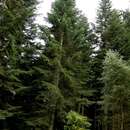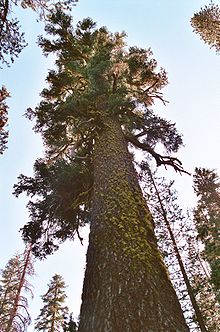en
names in breadcrumbs


Firs are evergreen coniferous trees belonging to the genus Abies (/ˈeɪbiˌiz/) in the family Pinaceae. There are approximately 48–56 extant species, found on mountains throughout much of North and Central America, Europe, Asia, and North Africa. The genus is most closely related to Cedrus (cedar).
The genus name is derived from the Latin "to rise" in reference to the height of its species.[2] The common English name originates with the Old Norse, fyri, or the Old Danish, fyr.[3]
They are large trees, reaching heights of 10–80 metres (33–262 feet) tall with trunk diameters of 0.5–4 m (1 ft 8 in – 13 ft 1 in) when mature. Firs can be distinguished from other members of the pine family by the way in which their needle-like leaves are attached singly to the branches with a base resembling a suction cup, and by their cones, which, like those of true cedars, stand upright on the branches like candles and disintegrate at maturity.
Identification of the different species is based on the size and arrangement of the leaves, the size and shape of the cones, and whether the bract scales of the cones are long and exserted, or short and hidden inside the cone.
A. grandis foliage – upper side of the leaves
Atypical A. alba foliage from Dinaric calcareous fir forests on Mt. Orjen
Firs can be distinguished from other members of the pine family by the unique attachment of their needle-like leaves to the twig by a base that resembles a small suction cup.
The leaves are significantly flattened, sometimes even looking like they are pressed, as in A. sibirica.
The leaves have two whitish lines on the bottom, each of which is formed by wax-covered stomatal bands. In most species, the upper surface of the leaves is uniformly green and shiny, without stomata or with a few on the tip, visible as whitish spots. Other species have the upper surface of leaves dull, gray-green or bluish-gray to silvery (glaucous), coated by wax with variable number of stomatal bands, and not always continuous. An example species with shiny green leaves is A. alba, and an example species with dull waxy leaves is A. concolor.
The tips of leaves are usually more or less notched (as in A. firma), but sometimes rounded or dull (as in A. concolor, A. magnifica) or sharp and prickly (as in A. bracteata, A. cephalonica, A. holophylla). The leaves of young plants are usually sharper.
The way they spread from the shoot is very diverse, only in some species comb-shaped, with the leaves arranged on two sides, flat (A. alba) [4]
The upper foliage is different on cone-bearing branches, with the leaves short, curved, and sharp.[5]
Intact and disintegrated Bulgarian fir cones
Immature cones of some species or races are green, not purple-bluish: for instance, Manchurian fir.
Firs differ from other conifers in having erect, cylindrical cones 5–25 cm (2–10 in) long that disintegrate at maturity to release the winged seeds.
In contrast to spruces, fir cones do not hang. Even large fir cones grow upwards like "candles", the new growth of the tree.
Mature cones are usually brown, young in summer can be green, for example:
or purple and blue, sometimes very dark:
Abies produce a variety of terpenoids. The analyses of the Zavarin group – from Smedman et al 1969 to Zavarin et al 1977 – showed variation in terpenoid composition of the bark by genetics, geography, age and size of the tree.[6][7]
The oldest pollen assignable to the genus dates to the Late Cretaceous in Siberia, with records of leaves and reproductive organs across the Northern Hemisphere from the Eocene onwards.[8]
Phylogeny of Abies[9][10] (Pseudotorreya)A. bracteata (Don) Poit.
(Religio) sectionA. mariesii Masters
A. amabilis (Douglas ex Loudon) Forbes
A. procera Rehder
Amabilis sectionA. magnifica Murray
Nobiles sectionA. concolor (Gordon) Lindley ex Hildebr.
A. jaliscana (Martínez) Mantilla, Shalisko & Vázquez
A. guatemalensis Rehder
A. hickelii Flous & Gaussen
A. flinckii Rushforth
A. vejarii Martínez
A. durangensis Martínez
A. religiosa (Kunth) von Schlechtendal & von Chamisso
A. hidalgensis Debreczy, Rácz & Guízar
A. grandis (Douglas ex Don) Lindley
A. lowiana (Gordon) Murray
Grandes (Abies) sectionA. alba Miller
A. pinsapo Boiss.
A. cephalonica Loudon
A. nebrodensis (Lojac.) Mattei
A. nordmanniana (Steven) Spach
A. numidica de Lannoy ex Carrière
A. ×borisii-regis Mattf.
A. cilicica (Antoine & Kotschy) Carrière
Abies sectionA. lasiocarpa (Hooker) Nuttall
A. ernestii Rehder
A. balsamea (von Linné) Miller
Balsamea sectionA. firma Siebold & Zuccarini
A. sibirica Ledeb.
Sibiria sectionA. fanjingshanensis Huang, Tu & Fang
A. ziyuanensis Fu & Mo
seriesA. kawakamii (Hayata) Itô
A. chensiensis van Tieghem
A. squamata Masters
A. pindrow (Royle ex Don) Royle
A. recurvata Masters
A. fargesii Franchet
Squamatae seriesA. koreana Wilson
A. nephrolepis (Trautvetter ex Maxim.) Maxim.
A. holophylla Maxim.
A. sachalinensis (Schmidt) Masters
A. fabri (Masters) Craib
A. veitchii Lindley
A. fraseri (Pursh) Poiret
A. delavayi Franchet
A. densa Griffith
A. spectabilis (Don) de Mirbel
A. nukiangensis Cheng & Fu
A. ferreana Bordères & Gaussen
A. forrestii Coltm.-Rog.
A. georgei Orr
A. homolepis Siebold & Zuccarini
A. yuanbaoshanensis Lu & Fu
Spectabiles PseudopiceaSection Abies is found in central, south, and eastern Europe and Asia Minor.
Section Balsamea is found in northern Asia and North America, and high mountains further south.
Section Grandis is found in western North America to Mexico, Guatemala, Honduras and El Salvador, in lowlands in the north, moderate altitudes in south.
Section Momi is found in east and central Asia and the Himalaya, generally at low to moderate altitudes.
Section Amabilis is found in the Pacific Coast mountains in North America and Japan, in high rainfall areas.

Section Pseudopicea is found in the Sino – Himalayan mountains at high altitudes.
Section Oiamel is found in central Mexico at high altitudes.

Section Nobilis (western U.S., high altitudes)
Section Bracteata (California coast)
Section Incertae sedis
Firs are used as food plants by the caterpillars of some Lepidoptera species, including Chionodes abella (recorded on white fir), autumnal moth, conifer swift (a pest of balsam fir), the engrailed, grey pug, mottled umber, pine beauty and the tortrix moths Cydia illutana (whose caterpillars are recorded to feed on European silver fir cone scales) and C. duplicana (on European silver fir bark around injuries or canker).

Wood of most firs is considered unsuitable for general timber use and is often used as pulp or for the manufacture of plywood and rough timber. Because this genus has no insect or decay resistance qualities after logging, it is generally recommended in construction purposes for indoor use only (e.g. indoor drywall on framing). Firwood left outside cannot be expected to last more than 12 to 18 months, depending on the type of climate it is exposed to.
Nordmann fir, noble fir, Fraser fir and balsam fir are popular Christmas trees, generally considered to be the best for this purpose, with aromatic foliage that does not shed many needles on drying out. Many are also decorative garden trees, notably Korean fir and Fraser fir, which produce brightly coloured cones even when very young, still only 1–2 m (3 ft 3 in – 6 ft 7 in) tall. Other firs can grow anywhere between 30 and 236 feet (9.1 and 71.9 m) tall. Many fir species are grown in botanic gardens and other specialist tree collections in Europe and North America.[11] Fir Tree Appreciation Day is June 18.
Abies religiosa—sacred fir, is the overwinter host for the monarch butterfly.[12][13]
Abies spectabilis or Talispatra is used in Ayurveda as an antitussive (cough suppressant) drug.[14][15]
{{cite journal}}: Cite journal requires |journal= (help) Firs are evergreen coniferous trees belonging to the genus Abies (/ˈeɪbiˌiz/) in the family Pinaceae. There are approximately 48–56 extant species, found on mountains throughout much of North and Central America, Europe, Asia, and North Africa. The genus is most closely related to Cedrus (cedar).
The genus name is derived from the Latin "to rise" in reference to the height of its species. The common English name originates with the Old Norse, fyri, or the Old Danish, fyr.
They are large trees, reaching heights of 10–80 metres (33–262 feet) tall with trunk diameters of 0.5–4 m (1 ft 8 in – 13 ft 1 in) when mature. Firs can be distinguished from other members of the pine family by the way in which their needle-like leaves are attached singly to the branches with a base resembling a suction cup, and by their cones, which, like those of true cedars, stand upright on the branches like candles and disintegrate at maturity.
Identification of the different species is based on the size and arrangement of the leaves, the size and shape of the cones, and whether the bract scales of the cones are long and exserted, or short and hidden inside the cone.